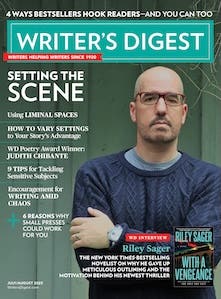“The How of Where” — The Importance of Setting in Your Fiction
David Rocklin, novelist and author of THE LUMINIST, explains the importance and value of creating a compelling setting in your writing fiction.
“All description is an opinion about the world.” -- Anne Enright
In some books, you scarcely recall where the narrative took place. Others could have unfolded anywhere, at any time. Perhaps this was a purposeful decision by the author – universality, timelessness. But if the story is intended to be a product of its setting, how to render that setting in a living way? How do you take it from backdrop to character?
Order a copy of David Rocklin's The Luminist today.
For me, historical fiction is no different than contemporary fiction in at least this way: I hope to glimpse my life. I may move through prehistoric caves, or walk the streets of Depression-era New York, or in the case of my novel, The Luminist, inhabit the neglected Ceylon estate of a colonial wife and the Tamil boy she draws into her obsessive pursuit of the first photographs. Wherever I am, I sift details of meals eaten in the upper and lower classes, clothes worn, slang uttered, how they slept and where they worked; I pin them to the prevailing forces of their world. Through those details, even fiction removed in time becomes immediate to me.
There are ways to uncover those details. I am drawn to old photographs, for example. Julia Margaret Cameron’s iconic portraits and her lesser known images of colonial Ceylon captivated me upon first encountering them, and they fueled my exploration of the themes that became the foundation of my book.
Writings (journals, newspapers, etc.) that are contemporaneous to the period, if available, can convey authentic voices and idioms. Old maps, their boundaries long since redrawn, nevertheless speak of vanished villages, dead rivers, or historic plagues. Biographies are wonderful tools for locating the threads of character and sociological/political backdrops from amongst the tangle of a finished life.
These are tools that can be used to do what is so difficult to do in creating your setting: resurrecting something that stopped existing before you started writing about it. The town, the house, the atmospherics of history, shift a little or a lot the moment your character begins to consider them.
Now, about the messy business of infusing place with character.
Imagine visiting someone you know well. Imagine sitting with them as you have a thousand times. Describe them. Now, tell yourself that they had a twin, who died tragically at an early age. You never knew that before. The narrative of your life with them has proceeded to this point without this information. But now you know.
Look at them again, and observe what has changed. What is different about the look in their eyes or the way they dress, or where they choose to live or what they do for work? Nothing. Everything. To render these differences, whether granular in detail or broadly stroked, is to make the character breathe.
Let’s apply this to setting. Find a room you’ve never seen. It has no meaning to you and holds nothing of your past life. You don’t know its contours, or how it looks on a cloudy morning. You can literally find one and occupy it, or find a picture and imagine yourself into it. Describe it. Tell the readers what we see. What we could touch, if only we were really there.
Now, describe the same room a second time. This time, give the room a story. This is where someone died. That chair was where a husband sat as his wife told him that she was leaving him. Out that window, a single mother watched a moving van pull up after losing the house to foreclosure.
What just happened? The room’s physical description changed, didn’t it? That’s not merely a bed. That’s not simply a street outside. The walls and their peeled paint have something akin to a voice. This setting isn’t just an edifice or a space anymore. It bears witness.
I think of Fitzgerald’s fictionalized Long Island, its eastern and western sides and the inlet between. DeLillo’s New York, violently reborn in the collapse of the twin towers. Hemingway’s sea, washing an old man away and back again, to a home that may no longer hold a place for him. I think of settings such as these and cannot help but know the characters that populate them.
David Rocklin, author of THE LUMINIST (Oct. 2011, Hawthorne Books), a debut Publishers Weekly called "beautifully written, …If Rocklin plays to his strengths, he will be a writer to watch." Rocklin grew up in Chicago and graduated from Indiana University. He lives in California with his wife and children. Find his author website here or follow him on Twitter.


